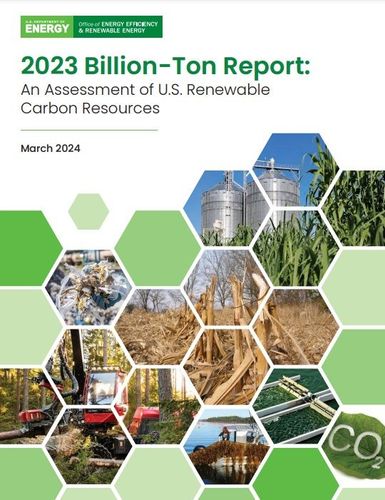DOE report explains how America can sustainably produce more than 1 billion tons of biomass per year

SOURCE: U.S. Department of Energy
March 15, 2024
BY U.S. Department of Energy
The U.S. Department of Energy today released the 2023 Billion-Ton Report (BT23), which shows that the U.S. could sustainably triple its production of biomass to more than 1 billion tons per year. The report—the fourth in a series of assessments of potential biomass resources in the United States since 2005—finds that 1 billion tons of biomass could satisfy over 100% of the projected demand for airplane fuel in the country, allowing the U.S. to fully decarbonize the aviation industry with sustainable aviation fuel (SAF). Advancing clean energy solutions like biomass is critical to reaching long-term national decarbonization objectives and a key component of President Biden’s Investing in America agenda to deliver new economic opportunities across the nation while tackling the climate crisis.
“President Biden is dedicated to building a thriving bioeconomy that benefits all Americans and ensures everyone from farmers and scientists to healthcare professionals and engineers can play a leading role in our clean energy future,” said U.S. Secretary of Energy Jennifer M. Granholm. “The Billion-Ton Report shows that America is poised to lead the world in the emerging renewable biomass industry—unlocking exciting economic opportunities for agricultural and rural communities and helping advance the sustainable fuels we need to cut harmful emissions and deliver healthier communities across the nation.”
The decarbonization of America’s transportation and industrial sectors depends on a significant increase in the production of renewable biomass for use in liquid fuel, bio-based chemicals, and other products. Highlights from the report include:
Advertisement
Advertisement
- The U.S. currently uses about 342 million tons of biomass, including corn grain for ethanol and wood/wood waste for heat and power, to meet roughly 5% of America’s annual energy demand
- The U.S. can triple the production of biomass, producing an estimated 60 billion gallons of low greenhouse gas liquid fuels, while still meeting the projected demand for food, feed, fiber, conventional forest products, and exports
- Currently available but unused biomass resources can add around 350 million tons of additional biomass per year above current uses and double the U.S. bioeconomy
- Biomass resources, like energy crops, in a future mature market can provide more than 400 million tons of biomass per year above current uses
- Further technological innovations could lead to evolving and emerging resources that represent additional biomass potential
- The analysis ensures sustainable outcomes by accounting for potential risks to soil, air and water quality, water availability, and the imperative to protect America’s forests and biodiversity
The BT23 report analyzes the biomass production capacity of approximately sixty resources, several of which have never before been the subject of a DOE Billion-Ton assessment. These include winter oilseed crops, trees and brush harvested from forests to prevent wildfires, macroalgae such as seaweed cultivated in ocean farms, and carbon dioxide from industrial plants. The report finds that the wide dispersion and variety of these resources will ensure that the benefits of expanded biomass production extend to both rural and urban areas.
Expanding the domestic production of sustainable biomass supports the Biden-Harris Administration’s whole-of-government approach to achieving net-zero emissions by 2050 and strengthening U.S. international leadership in clean energy. It also supports the Sustainable Aviation Fuel Grand Challenge, which aims to reduce life cycle greenhouse gas emissions from SAF by 50% compared to conventional fuel, and the Clean Fuels & Products Energy Earthshot™, which aims to decarbonize the fuel and chemical industry through alternative sources of carbon.
Advertisement
Advertisement
BT23, developed by Oak Ridge National Laboratory on behalf of DOE’s Bioenergy Technologies Office, reflects the contributions and reviews of multiple federal agencies, national laboratories, universities, and industry stakeholders. Learn more about the 2023 Billion-Ton Report.
Additionally, the U.S. Department of Agriculture recently released the Plan to Enable the Bioeconomy in America: Building a Resilient Biomass Supply report, which outlines a plan to boost biomass supply chain resiliency for domestic biobased product manufacturing while also advancing environmental sustainability and market opportunities for small and mid-sized producers.
Visit the Bioenergy Technologies Office webpage to learn more about DOE’s efforts to build a strong, low-carbon bioeconomy.
Related Stories
The USDA significantly increased its estimate for 2025-’26 soybean oil use in biofuel production in its latest World Agricultural Supply and Demand Estimates report, released July 11. The outlook for soybean production was revised down.
U.S. fuel ethanol capacity fell slightly in April, while biodiesel and renewable diesel capacity held steady, according to data released by the U.S. EIA on June 30. Feedstock consumption was down when compared to the previous month.
The U.S. EPA on July 8 hosted virtual public hearing to gather input on the agency’s recently released proposed rule to set 2026 and 2027 RFS RVOs. Members of the biofuel industry were among those to offer testimony during the event.
The USDA’s Risk Management Agency is implementing multiple changes to the Camelina pilot insurance program for the 2026 and succeeding crop years. The changes will expand coverage options and provide greater flexibility for producers.
President Trump on July 4 signed the “One Big Beautiful Bill Act.” The legislation extends and updates the 45Z credit and revives a tax credit benefiting small biodiesel producers but repeals several other bioenergy-related tax incentives.
Upcoming Events










